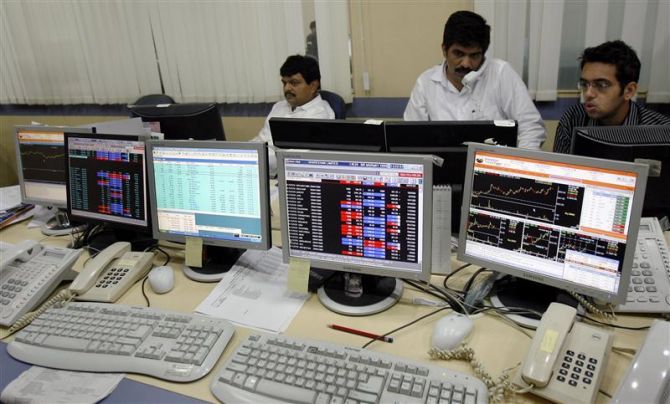 | « Back to article | Print this article |
If the cream of the corporate world, represented by the 30 Sensex stocks, gained 12.5 per cent, the broader universe of listed companies performed much lower than this, say, an average of seven or eight per cent.
 When Narendra Modi took oath as the prime minister, exactly a year earlier, the BSE Sensex was trading at 24,700.
When Narendra Modi took oath as the prime minister, exactly a year earlier, the BSE Sensex was trading at 24,700.
As this piece was being written, it was trading around 27,800, is a gain of 3,100 points or 12.5 per cent.
Let us read backwards the story often peddled to stock investors.
A year of Modi Sarkar fails to impress Dalal Street
If the cream of the corporate world, represented by the 30 Sensex stocks, gained 12.5 per cent, the broader universe of listed companies performed much lower than this, say, an average of seven or eight per cent.
That would mean other sectors of the economy which are not as profitable and efficient as these corporations did even worse.
Where does that leave the economy as a whole?
In comparison, in its first year in office, the Manmohan Singh-led United Progressive Alliance (UPA) government saw the Sensex rise from 5,123 on May 24, 2004, to 6,539 points on May 23, 2005.
One year of Modi sarkar: Complete coverage
That gain of 1,416 points amounting to 27.64 per cent set up a strong foundation for a formidable rally that saw the Sensex rise three-fold to hit 21,000 in the following three years.
When the second UPA regime began, the index went from 13,913 points on May 25, 2009, to 16,469 on May 24, 2010, a gain of 2,556 points or 18.4 per cent.
You might think that to be a very narrow way of looking at things. Let us look at the number for primary markets, which flourishes only if there is buoyancy of the secondary markets.
According to Prime Database numbers, the amount of capital raised since the beginning of FY15 is Rs 29,705 crore or Rs 297.05 billion from 36 public issues, including initial public offerings, offer for sales and follow-on offerings.
The comparable number available with it for financial year 2004-05 under UPA-I was 29 issues raising Rs 21,432 crore or Rs 214.32 billion.
The first year of UPA-II, 2009-10, saw 44 public issues raising Rs 46,941 crore or Rs 469.41 billion, despite bearing the brunt of post-Lehman hangovers.
Another catch here is that the bulk of the money raised in 2014-15 was by the government itself, through the disinvestment programme.
About Rs 24,000 crore or 81 per cent was raised by the government, of which Rs 22,557 crore or Rs 225.57 billion was raised by the Coal India issue alone.
In comparison, while UPA-I did not have disinvestments, these accounted for less than half the money raised during the first year of UPA-II.
One year of Modi sarkar: Complete coverage
The remaining 30-odd private sector issues raised less than Rs 6,000 crore or Rs 60 billion, at an average of around Rs 200 crore or Rs 2 billion under the Modi regime.
Thus, small investors have not had any great offerings from the private sector, despite the Modi promise of reviving the economy and finance minister Arun Jaitley’s repeated claims that global investors are now viewing the country’s economy and its potential in a very different light.
One parameter that has shown a significant jump over the previous financial year is the number of qualified institutional placements (QIPs), an instrument that allows corporations to raise money quickly, by placing shares with big funds.
As many as 44 QIPs raised Rs 28,429 crore or Rs 284.29 billion in FY15.
While the sum raised was thrice the amount raised in 2013-14 and seven times in terms of number of issues, it was still less than the 67 QIPs that raised Rs 43,968 crore in 2009-10, the first year of UPA-II. QIP came into being towards the end of the first year of the first UPA regime.
The Street must be hoping that some such money-spinning innovation comes from the Modi sarkar in at least its second year.